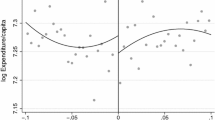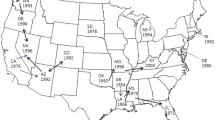Abstract
Legislation would be a Samuelsonian public good if the cost of creating legislation is not a function of the number of people covered by the legislation. A straighforward test of Samuelsonian publicness is undertaken by estimating the cost of producing legislation as a function of population and other variables, using cross-sectional data from the states of the United States for the years 1965, 1975, and 1985. The empirical results indicate that while legislation does have some degree of publicness, legislation is mostly a private good, and that it has been becoming increasingly less public over time.
Similar content being viewed by others
References
Barnett, R.R., Levaggi, R. and Smith P. (1991). Does the flypaper model stick? A test of the relative performance of the flypaper and conventional models of local government budgetary behavior.Public Choice 69(1) (February): 1–18.
Barr, J.L. and Davis, O.A. (1966). An elementary political and economic theory of the expenditures of state and local governments.Southern Economic Journal 33 (October): 149–165.
Bator, F.M. (1958). The anatomy of market failure.Quarterly Journal of Economics 72 (August): 351–379.
Benson, B.L. and Engen, E.M. (1988). The market for laws: An economic analysis of legislation.Southern Economic Journal 54(3) (January): 732–745.
Bergstrom, T.C. and Goodman, R. (1973). Private demand for public goods.American Economic Review 63 (June): 280–296.
Borcherding, T.E. and Deacon, R.T. (1972). The demand for the sevices of non-federal governments.American Economic Review 62 (December): 891–901.
Bradford, D.F. and Oates, W.E. (1971). The analysis of revenue sharing in a new approach to collective fiscal decisions.Quarterly Journal of Economics 85(3) (August): 416–439.
Davis, O.A. and Hanes, G.H. (1966). A political approach to a theory of public expenditure: The case of municipalities.National Tax Journal 29(3) (September): 259–275.
Deno, K.T. and Mehay, S.L. (1987). Municipal management structure and fiscal performance: Do city managers make a difference?Southern Economic Journal 53(3) (January): 627–642.
Feenberg, D.R. and Rosen, H.S. (1985). State personal income and sales taxes: 1977–1983. NBER Working Paper Series, Working Paper No. 1631. National Bureau of Economic Research, Cambridge, MA.
Gramlich, E.M. (1968). Alternative federal policies for stimulating state and local expenditures: A comparison of their effects.National Tax Journal 21(2) (June): 119–129.
Gwartney, J.D. and Stroup, R.L. (1992).Economics: Private and public choice. Fort Worth: Dryden Press.
Hamilton, B.W. (1983). The flypaper effect and other anomalies.Journal of Public Economics 22(3) (December): 347–361.
Hayek, F.A. (1973).Law, legislation, and liberty, Vol. 1. Chicago: University of Chicago Press.
Holcombe, R.G. (1985).Public finance and the political process. Carbondale: Southern Illinois University Press.
Holcombe, R.G. (1992). The distributive model of government: Evidence from the Confederate Constitution.Southern Economic Journal 58(3) (January): 762–769.
Hughes, J.R.T. (1977).The governmental habit. New York: Basic Books.
Inman, R.P. (1978). Testing political economy's ‘as if’ assumption: Is the median income voter really decisive?Public Choice 33(4): 45–65.
McCormick, R.E. and Tollison, R.D. (1981).Politicians, legislation and the economy. Boston: Martinus Nijhoff.
Mueller, D.C. (1989).Public choice II. Cambridge: Cambridge University Press.
Perkins, G. (1977). Demand for local public goods: Elasticities of demand for own price, cross prices, and income.National Tax Journal 30: 411–422.
Samuelson, P.A. (1954). The pure theory of public expenditure.Review of Economics and Statistics 36 (November): 387–389.
Samuelson, P.A. (1955). A diagrammatic exposition of a theory of public expenditure.Review of Economics and Statistics 37 (November): 350–356.
Samuelson, P.A. (1964). Public goods and subscription TV: Correction of the record.Journal of Law & Economics 7 (October): 81–83.
Weingast, B.R., Shepsle, K.A. and Johnsen, C. (1981). The political economy of benefits and costs: A neoclassical approach to distributive politics.Journal of Political Economy 89(4) (August): 642–664.
Wilde, J.A. (1968). The expenditure effects of grant-in-aid programs.National Tax Journal 21(3) (September): 340–348.
Author information
Authors and Affiliations
Additional information
The authors gratefully acknowledge the helpful comments of Bruce Benson, Tim Sass, and an anonymous referee of this journal.
Rights and permissions
About this article
Cite this article
Holcombe, R.G., Sobel, R.S. Empirical evidence on the publicness of state legislative activities. Public Choice 83, 47–58 (1995). https://doi.org/10.1007/BF01047682
Accepted:
Issue Date:
DOI: https://doi.org/10.1007/BF01047682




